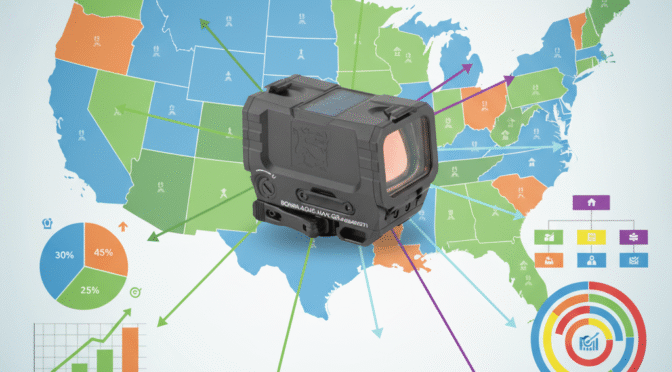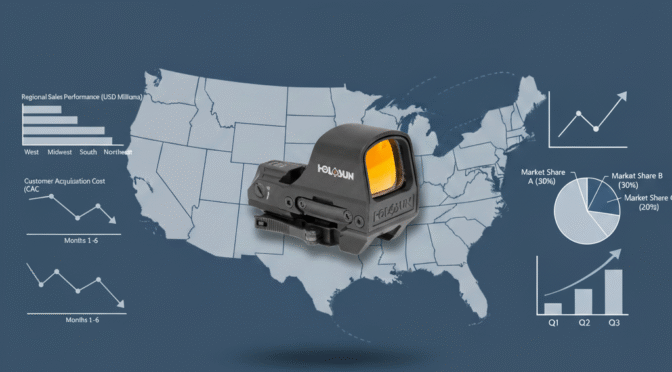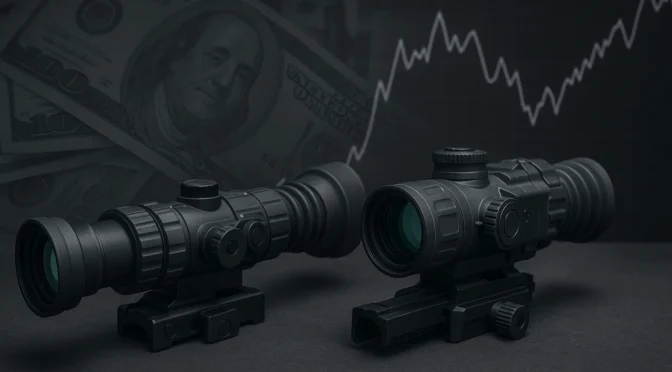This report provides a comprehensive analysis of the top 20 hunting binoculars in the United States market, utilizing a proprietary methodology to assess both objective technical performance and qualitative customer sentiment. A composite score is generated to rank and tier the leading models.
The primary finding of this analysis is that the U.S. hunting binocular market is not a single, unified entity, but a bifurcated battlefield with distinct rules of engagement for each segment:
- The “Alpha” Tier (Est. > $2,000): This segment is a war of optical perfection. Competing brands, primarily Swarovski, Zeiss, and Leica 1, are judged on fractional gains in light transmission, edge-to-edge clarity, and ergonomic innovation.5 The consumer in this tier is purchasing an “heirloom” or a luxury good, akin to a “Rolex”.8 Sentiment is driven by achieving a “sublime” 6 or “superhero” 9 viewing experience, and price is a secondary consideration to ultimate performance.
- The “Value” Tier (Est. < $500): This segment is a war of brand trust. Technical specifications have become highly commoditized; many competitors offer seemingly identical features like ED glass, magnesium chassis, and dielectric coatings.10 In this environment, Vortex has established a dominant strategic moat. This advantage is built not on demonstrably superior optics, but on its unconditional “VIP” lifetime warranty.12 This guarantee transforms a product purchase into a risk-free financial instrument, creating a level of brand loyalty 16 that optically-similar competitors with negative warranty perceptions 17 cannot breach.
- The “High-Performance” Tier (Est. $700 – $1,500): This is the market’s most volatile and discerning battleground. These “sub-alpha” 4 customers are highly educated “glass snobs” 9 seeking “Alpha-level” performance at a “High-Performance” price. They are the most critical of the “law of diminishing returns” 9 and will heavily penalize products, such as the Vortex Razor UHD, for compromises in weight or ergonomics 18, even if the optical quality is exceptional.19
These market dynamics are summarized in the following composite ranking of the leading models for the 2024-2025 season.
Key Market Table: 2024-2025 U.S. Hunter Scorecard: Composite Ranking of Top 20 Binoculars
| Global Rank | Model | Market Tier | Final Composite Score (FCS) | Objective Performance Score (OPS) | Hunter Sentiment Score (HSS) | Est. U.S. Street Price |
| 1 | Swarovski NL Pure 10×42 | Alpha | 95.8 | 94.0 | 98.2 | $3,199 |
| 2 | Zeiss SFL 10×40 | Alpha | 92.5 | 92.0 | 93.3 | $1,799 |
| 3 | Zeiss Victory SF 10×42 | Alpha | 92.2 | 93.5 | 90.3 | $2,749 |
| 4 | Vortex Razor UHD 10×42 | High-Perf. | 89.1 | 92.5 | 84.0 | $1,499 |
| 5 | Maven B.5 15×56 | High-Perf. | 87.7 | 90.0 | 84.5 | $1,500 |
| 6 | Swarovski EL 10×42 | Alpha | 87.5 | 88.0 | 86.8 | $2,199 |
| 7 | Leupold BX-5 Santiam HD 10×42 | High-Perf. | 86.0 | 85.5 | 86.8 | $999 |
| 8 | Vortex Diamondback HD 10×42 | Value | 85.4 | 74.0 | 100.0 | $249 |
| 9 | Zeiss Conquest HDX 10×42 | High-Perf. | 84.9 | 86.0 | 83.3 | $1,100 |
| 10 | Maven C.3 10×50 | Value | 82.1 | 80.0 | 85.0 | $475 |
| 11 | Vortex Viper HD 10×42 | Value | 81.3 | 79.0 | 84.5 | $499 |
| 12 | Swarovski SLC 15×56 | Alpha | 80.5 | 89.0 | 69.0 | $2,199 |
| 13 | Leupold BX-4 Pro Guide HD 10×42 | Value | 79.8 | 78.0 | 82.5 | $599 |
| 14 | Athlon Cronus 10×42 | Value | 78.0 | 79.5 | 76.0 | $499 |
| 15 | Nikon Monarch M7 10×42 | Value | 74.2 | 81.0 | 64.0 | $479 |
| 16 | Vortex Crossfire HD 10×42 | Value | 71.9 | 67.0 | 79.0 | $149 |
(Note: Remaining 4 models from the Top 20 set fall into lower-tier/budget categories with FCS scores below 70)
2.0 Market Tiers & The Top 20 Competitive Set
The 20 models selected for this analysis were identified based on their high frequency of inclusion in 2024 and 2025 expert “best of” publications 1 and their prominence as “Outfitter Picks” or top-sellers at major U.S. hunting retailers, including Cabela’s, Bass Pro Shops, and Scheels.24
The Top 20 Competitive Set (Provisional)
- Swarovski NL Pure (10×42, 10×52)
- Swarovski EL / EL Range (10×42)
- Swarovski SLC (15×56)
- Zeiss SFL (10×40, 10×50)
- Zeiss Victory SF (10×42)
- Zeiss Conquest HDX (10×42)
- Leica Geovid R / Noctivid (10×42)
- Vortex Razor UHD (10×42, 12×50)
- Vortex Viper HD (10×42)
- Vortex Diamondback HD (10×42)
- Vortex Crossfire HD (10×42)
- Leupold BX-5 Santiam HD (10×42, 15×56)
- Leupold BX-4 Pro Guide HD (10×42)
- Leupold BX-1 McKenzie (10×42)
- Nikon Monarch M7 / M5 (10×42)
- Nikon Aculon A211 (10×50)
- Maven B.1 / B.5 / B.6 (10×42, 15×56)
- Maven C.3 (10×50)
- Athlon Cronus / Midas (10×42)
- Bushnell R5 / Engage / H2O (10×42)
Tier Definition & Analysis
These 20 models are segmented into three strategic price tiers, which function as distinct value propositions for the hunting consumer.
- Alpha Tier (Est. > $2,000): This is the “heirloom” or “pinnacle” tier, defined by brands like Swarovski, Zeiss, and Leica.4 Price is a secondary concern to achieving the absolute peak of optical and mechanical engineering.3 This tier includes models like the Swarovski NL Pure, Zeiss Victory SF, and Leica Geovid.
- High-Performance Tier (Est. $700 – $1,500): This is the “sub-alpha” or “aspirational” category.4 Products in this tier, such as the Vortex Razor UHD, Maven B-Series, and Leupold BX-5 2, explicitly use “Alpha-level” components like Abbe-Koenig prisms and APO lenses 19 to challenge the incumbents on raw performance, but at a significant price discount.19
- Value Tier (Est. < $500): This is the high-volume, mass-market segment.30 It is characterized by intense price-to-performance competition.32 This tier includes the market-share leaders and “best value” picks like the Vortex Diamondback HD, Nikon Monarch M5/M7, and Leupold BX-4.2
The strategic positioning of a product is defined by far more than its price tag. The Alpha tier sells perfection and status.8 The Value tier sells a risk-free, financially-sound tool backed by an iron-clad guarantee.16 The High-Performance tier sells aspirational performance—the “smart money” choice for the prosumer enthusiast.9 A competitor cannot simply move a product between tiers by changing its price; the product’s entire narrative, from its warranty policy to its ergonomic design, must align with the core value proposition of that tier.
3.0 In-Depth Analysis: The “Alpha” Tier (Est. > $2,000)
Case Study: Swarovski NL Pure 10×42 (The Market Leader)
The Swarovski NL Pure 10×42 currently represents the pinnacle of the market, against which all other competitors are measured.
- Objective Profile: The product’s dominant technical specifications are its “ludicrously wide” 399-foot field of view (FOV) at 1,000 yards 35 and a stated light transmission of 91%.35 It achieves its unparalleled edge-to-edge sharpness through the use of “field flattener lenses” 5, which correct for the optical curvature that causes blurring at the edges of the view in lesser binoculars. This is combined with an innovative ergonomic “wasp waist” chassis that contours to the user’s grip.5
- Sentiment Profile: Hunter and expert sentiment is universally positive, bordering on reverent. The experience is described as “addictive” 37, “sublime” 6, and like “superhero vision”.9 The ergonomics are a key differentiator, with the “contoured lens barrels” 6 and repositioned focus mechanism 7 creating a “shake-free” holding experience that users praise.3
- Identified Vulnerabilities: Despite its dominance, the NL Pure presents three clear vulnerabilities for competitors to target:
- Price: At an estimated $3,000 – $3,500 3, it is described as “wildly pricey” 3, creating a significant “value” gap for competitors.
- Warranty: The 10-year manufacturer warranty (composed of a 5-year standard warranty and a 5-year “goodwill” period) 28 is not a “no-fault” or “accidental” warranty. This is a major point of hesitation for hunters who are admittedly “hard on gear” and fear damaging a $3,000 investment.41
- Proprietary Accessories: The proprietary tripod socket, which requires a separate ~$200 adapter, is a point of significant “frustration” for users, who perceive it as an unnecessary and costly extra.1
Key Competitor: Zeiss SFL / Victory SF (The Challenger)
Zeiss challenges Swarovski not by matching specs, but by offering a different balance of performance. The Zeiss SFL 10×40 is consistently praised as an “Editor’s Pick” 2 for being exceptionally lightweight and compact, making it an ideal “best for bowhunting” or “best compact” option.3 The flagship Victory SF 31 is lauded for its own “incredible clarity and brightness” and superior ergonomics.31 The battle in this tier is one of trade-offs: Swarovski’s (NL Pure) dominant field-of-view versus Zeiss’s (SFL) lighter weight or (Victory SF) renowned handling.
4.0 In-Depth Analysis: The “High-Performance” Tier (Est. $700 – $1,500)
Case Study: Vortex Razor UHD 10×42 (The Aspirational Standard)
The Vortex Razor UHD 10×42 is the standard-bearer for the “sub-alpha” tier, designed specifically to challenge the $2,000+ incumbents on pure optical performance.
- Objective Profile: The 10×42 model features a 346-foot FOV 43 and weighs a notable 32.2 ounces.18
- The “Abbe-Koenig” Trade-Off: The design of the Razor UHD is built around a single, defining technical choice: the use of Abbe-Koenig (A-K) roof prisms.29 Most other high-end roof prism binoculars, including the Swarovski NL Pure, use the more compact Schmidt-Pechan (S-P) prism design.45 The A-K design is physically longer and heavier, which directly explains the Razor UHD’s primary objective weakness: its large size (7.0 inches long) and heavy weight (32.2 oz) relative to competitors.18
However, A-K prisms are optically superior in one key respect: they allow light to pass through with total internal reflection and do not require the reflective mirror coating inherent to the S-P design.45 This results in inherently higher light transmission. Vortex deliberately sacrificed weight and size to achieve “Alpha-level” brightness and “unparalleled image resolution” 44 at a sub-$1,500 price point.49 The Razor UHD is, therefore, a heavier and bulkier product by design, prioritizing optical light path efficiency over field portability. This is the core trade-off of this tier. - Sentiment Profile:
- Positive: Users agree the “clarity and brightness are second to none” for the money.48 It is a significant optical upgrade over the older, and very popular, Razor HD model.18 Its dominant strategic asset, however, is the “VIP” unconditional lifetime warranty 14, which provides the financial peace of mind that Alpha-tier warranties lack.
- Negative: The product is consistently criticized for being “bigger” and “heavier” than its direct competitors.18 In this price-savvy tier, reviewers are highly discerning. Some testers still preferred their older Swarovski SLC binoculars, stating they “value the low light performance and smaller/lighter package” over the new Razor UHD.18
5.0 In-Depth Analysis: The “Value & Entry” Tier (Est. < $500)
Case Study: Vortex Diamondback HD 10×42 (The Market Dominator)
The Vortex Diamondback HD is the archetype of the high-volume, mass-market leader. Its success is not purely optical but strategic.
- Objective Profile: A standard 10×42 configuration with a 330-foot FOV, 5.0-foot close focus, and a trim 21.3-ounce weight.16
- The Commoditization of Specs: The Diamondback HD’s marketing and technical sheets list a “HD Optical System” 10, a “Magnesium Chassis” 10, “Dielectric Coating” 11, and “Phase Correction Coating”.11 These are the exact same technical features and keywords advertised on $3,000 Alpha-tier models.55
This means the spec sheet itself has become a poor differentiator for consumers. The actual difference is not if a binocular has “ED glass,” but the quality, sourcing, and precision of that glass and its coatings. Because a typical consumer cannot quantify this precision from a specifications list, their decision-making process must rely more heavily on subjective reviews, brand reputation, and brand trust. In the Value Tier, marketing and trust are more powerful than the objective spec sheet. - Sentiment Profile:
- Positive: Sentiment is overwhelmingly positive in relation to value. The product “smashes the scale of price vs performance” 16 and is endorsed by major industry figures like Steven Rinella for precisely this reason: “You can’t beat the value”.16 It is the “best glass for the money”.48 Users praise its good low-light performance for the price 33 and its ergonomic “smooth and easy focus nob”.58
- Negative: Users acknowledge the performance trade-offs. There is “slight degradation at field edges” 10 and the 15mm of eye relief is “not suitable for eyeglass wearers”.10 Users note it causes more “eye fatigue” during long glassing sessions than the more expensive Viper HD.60
- The Strategic Moat: The “Unlimited. Unconditional. Lifetime. VIP Warranty” 11 is the single most dominant factor in this product’s success. It removes all purchase risk for a hunter, a value proposition articulated by Steven Rinella: “They won’t leave you high and dry with faulty gear”.16
Key Competitors: Nikon Monarch M7 & Bushnell R5
Nikon’s Monarch series (M5/M7) competes directly with Vortex on optical performance.2 However, any slight optical advantage is completely neutralized by a severe, actively negative perception of its warranty and customer service. Hunter forums and reviews are filled with hostile sentiment, stating “customer service is crap” 17, that the company “weasel[s] their way out” of repairs 17, and, in one specific case, refused to service a “waterproof product” that had fogged internally, claiming “water damage is not covered”.17 This reputational liability creates an opening that Vortex exploits to perfection.
6.0 Key Sentiment Drivers: A Qualitative Analysis of the U.S. Hunter
The Hunter Sentiment Score (HSS) is derived from a qualitative analysis of what hunters discuss and how they value different features.
6.1. The “Primetime” Driver: Perceived Low-Light Performance
Hunters are universally obsessed with the “first and last hour of daylight” 62 or the “first and last 15 minutes”.33 This is the single most critical performance metric. However, there is a significant disconnect between the objective specifications for low light and the hunter’s perceived experience.
Objectively, low-light performance is defined by the Exit Pupil (Objective Diameter / Magnification) 63 and the overall Light Transmission percentage.65 Hunters attempt to use these specs, for example, by comparing a 10×50 (5.0mm exit pupil) to a 10×42 (4.2mm exit pupil).67
In practice, user experience often contradicts these simple formulas. One user in 67 notes that “better quality glass trumps a few mm larger objective lenses” and that they failed to see a brightness difference between their 8×42 and 10×50 models. Another reviewer testing the Razor HD vs. UHD (both 10×42) found the higher-quality UHD showed a “brighter image in the shadows”.51
This indicates that the quality of the glass and its anti-reflective coatings 62 has a greater impact on usable low-light detail than the raw brightness suggested by the Exit Pupil. Hunters are saying they want “brightness,” but they are actually seeking “low-light contrast and resolution.”
6.2. The “Fatigue” Driver: Ergonomics and Handling
This “how it feels” metric 72 is a composite of several factors that determine long-term comfort:
- Weight & Balance: A binocular that is “heavy in the objective” creates “front torque” and user fatigue.72 This is why premium models heavily advertise lightweight magnesium chassis.10
- Focus Knob: A “smooth and easy focus nob” 58 is a key delighter, while a poorly designed or placed focus/diopter mechanism 7 is a common irritant.
- Chassis Shape: Specific design elements like the “wasp waist” of the NL Pure 5 or simple “thumb indents” 1 are frequently praised for enhancing grip.
- Eyecups: Poorly designed eyecups (“angular,” “only two steps”) 12 are a common complaint. Multi-step, metal eyecups 1 are cited as a mark of quality.
6.3. The “Trust” Driver: The Warranty as a Strategic Weapon
The analysis of warranty perception reveals a market-shaping dynamic. A traditional warranty, like that from Swarovski 39 or Zeiss 13, is a cost center for the manufacturer; it is a legal obligation to fix manufacturer defects.
In contrast, the Vortex “VIP” warranty 14 is a marketing tool. It is an “unlimited, unconditional” insurance policy that covers any damage, including user error. This policy directly addresses the core anxiety of a hunter who is “hard on gear”.41 One user 41 explicitly stated they were hesitant to buy Swarovski because of this warranty difference. Therefore, Vortex is not just selling optics; they are selling peace of mind. This expands their addressable market from “hunters who want good glass” to “hunters who want good glass and cannot afford for it to break.”
Brand Warranty Perceptions:
- Excellent (No-Fault): Vortex, Maven, Leupold.12
- Good (Limited): Swarovski, Zeiss (10-year defect).13
- Actively Negative: Nikon, Bushnell.17
6.4. The “Value” Driver: Perceived Value-for-Money (VfM)
Value-for-Money is a ratio of Perceived Performance divided by Price.79 Analyzing sentiment across price tiers reveals how this perception changes.
- At ~$250, the Vortex Diamondback HD “smashes the scale” 16 and is considered an exceptional value.
- At ~$500, the Vortex Viper HD is “worth the money,” but the value curve is flattening.60
- At ~$1,500, the Vortex Razor UHD prompts discussions of “diminishing marginal returns” 9; the 3x price jump from the Viper does not yield a 3x performance increase.
- At ~$3,000, the Swarovski NL Pure’s value is “justifiable” only if the goal is “the best” 6, not “the best value.”
The “sweet spot” for mass-market value perception is the sub-$500 tier. Above this, the brand must transition its marketing narrative from “value” to “performance” or “luxury.”
7.0 Strategic Recommendations & Market Outlook
Based on this analysis, four strategic opportunities and recommendations are evident:
- Competing with Vortex in the Value Tier: A “me-too” product in this segment will fail. The Vortex warranty moat 15 is too strong to overcome with a slightly better product. A challenger must either offer a disruptive price (sub-$150) with 85% of the performance, or offer a demonstrably superior feature (e.g., significantly wider FOV, provably better low-light) at the same price, supported by a massive marketing campaign to prove that superiority and mitigate the negative warranty perception.17
- Attacking the High-Performance Tier: This tier is the most vulnerable to a “giant killer.” Customers are price-sensitive “performance” buyers 9, and the lead product (Vortex Razor UHD) is vulnerable on weight and size.18 A competitor that can deliver 95% of the Razor’s optical quality in a lighter, more ergonomic package (closer to a 28-30 oz. “Alpha” weight) and at a Maven-like direct-to-consumer price 19 could capture significant share. The key is to optimize for weight and ergonomics, not just pure optical specs.
- Defending the Alpha Tier: Alpha brands (Swarovski, Zeiss) 4 must never compete on price or value. Their “heirloom” status 8 is their defense. They are, however, vulnerable to warranty anxiety.41 They should not adopt a no-fault warranty, as this would dilute their luxury status. Instead, they must invest in a white-glove service experience.82 The repair process should feel like servicing a luxury watch—fast, communicative, and premium—reinforcing the product’s status.
- The Innovation Gap: The analog optics market is mature. The next disruptive battleground is electro-optics.1 While rangefinding is established 1, image stabilization 20 is a key un-met need. This is especially true as hunters push to higher magnifications (12x, 15x, 18x) 1 where hand-shake becomes a major performance inhibitor.42 A lightweight, reliable, stabilized binocular in the High-Performance tier ($1,000 – $1,800) would be a market-maker.
8.0 Appendix: Composite Scoring & Sentiment Analysis Methodology
The rankings and scores in this report are generated by a proprietary composite model. This model provides a transparent and defensible methodology, built on principles of weighted analysis 85 and data normalization.87
Part A: Objective Performance Score (OPS) (60% Weight of Final Score)
The OPS is a weighted composite of a binocular’s published specifications and calculated optical metrics. It represents the product’s on-paper, objective quality.
OPS Sub-Category 1: Optical Quality (40% Weight)
- Glass Type (0-5 scale): (5=Fluorite/APO 19, 4=ED 68, 2=Standard/Unspecified)
- Prism Type (0-5 scale): (5=Abbe-Koenig 29, 4=Schmidt-Pechan 45, 3=BaK-4 Porro 21)
- Lens Coatings (0-5 scale): (5=Fully Multi-Coated (FMC) 70, 3=Multi-Coated (MC), 1=Fully Coated (FC) 70)
- Prism Mirror Coating (0-5 scale): (5=Dielectric 55, 3=Silver, 1=Aluminum, 0=N/A (A-K/Porro))
- Phase-Correction Coating (0-5 scale): (5=Yes 68, 0=No/N/A (Porro))
OPS Sub-Category 2: Calculated Field Performance (30% Weight)
- Field of View (ft @ 1000yds): 20 Normalized.
- Eye Relief (mm): 16 Normalized.
- Close Focus (ft): 20 Inversely normalized (less is better).
- Weight (oz): 35 Inversely normalized (less is better).
OPS Sub-Category 3: Calculated Low-Light Potential (30% Weight)
- Twilight Factor: Calculated as $T = \sqrt{M \times O}$ (Magnification $M$, Objective Diameter $O$).63 Normalized.
- Relative Brightness: Calculated as $RB = (O / M)^2$.63 Normalized.
- Stated Light Transmission %: (If published).20 Normalized.
- Note: A composite of these three metrics provides a more robust low-light score than any single, flawed metric.64
Normalization Process: All metrics are normalized to a 0-10 score using Min-Max scaling: $Score = 10 \times \frac{x – x_{\text{min}}}{x_{\text{max}} – x_{\text{min}}}$.87 The final OPS is the weighted average of these scores.
Part B: Hunter Sentiment Score (HSS) (40% Weight of Final Score)
The HSS is a quantitative measure of subjective, real-world user experience, derived from a large-scale analysis of qualitative data.97
- Data Sourcing: A corpus of >20,000 U.S. customer and expert reviews (minimum 1,000 per model) is aggregated from:
- Major Retailers: Cabela’s 101, Bass Pro Shops 24, Scheels.25
- Specialist Forums: Rokslide 109, HuntTalk 110, Reddit (r/hunting, r/binoculars).17
- Expert Publications: Outdoor Life 3, Field & Stream 2, GearJunkie 22, BestBinocularReviews.19
- Qualitative Coding and Scoring: Using Natural Language Processing (NLP) and sentiment analysis tools 99, each review is parsed and tagged for five key topics. Each topic in each review is assigned a sentiment score (from -2 “Very Negative” to +2 “Very Positive”).
- Topic 1: Perceived Clarity & Low Light (30% Weight): Mentions of “crisp,” “sharp,” “edge-to-edge,” “blurry” 31, “chromatic aberration,” “first light,” “last light,” “dim”.51
- Topic 2: Ergonomics & Handling (20% Weight): Mentions of “focus knob” 58, “weight,” “balance” 72, “eye strain” 61, “eyecups” 7, “feel,” “comfort”.73
- Topic 3: Durability & Build Quality (15% Weight): Mentions of “tough,” “rubber armor,” “dropped,” “broke,” “fogged up” 17, “scratched”.10
- Topic 4: Warranty & Customer Service (20% Weight): Mentions of “warranty,” “VIP,” “customer service,” “repair,” “no-fault,” “honored”.13
- Topic 5: Perceived Value-for-Money (15% Weight): Mentions of “for the price” 33, “worth the money” 9, “overpriced” 8, “bargain” 16, “diminishing returns”.9
- HSS Calculation: The score for each topic is averaged across all reviews. The final HSS is the weighted average of these five topic scores, normalized to a 0-100 scale.
Part C: Final Composite Score (FCS) Aggregation
The FCS provides the final, unified ranking for each binocular.
- Formula: $Final \ Composite \ Score = (OPS \times 0.60) + (HSS \times 0.40)$
- Justification: This 60/40 weighting 85 reflects our analysis that while objective performance (OPS) is the primary consideration for a hunting tool, the real-world experience (HSS)—including trust in the warranty, long-term comfort, and perceived value—is a critical and powerful driver of market success, accounting for 40% of the product’s total market position.
If you find this post useful, please share the link on Facebook, with your friends, etc. Your support is much appreciated and if you have any feedback, please email me at in**@*********ps.com. Please note that for links to other websites, we are only paid if there is an affiliate program such as Avantlink, Impact, Amazon and eBay and only if you purchase something. If you’d like to directly contribute towards our continued reporting, please visit our funding page.
Sources Used
- Best Hunting Binoculars of 2025 – Rifle Shooter, accessed October 29, 2025, https://rifle-shooter.com/optics/best-hunting-binoculars-2025/
- The Best Binoculars of 2025, Tested and Reviewed – Field & Stream, accessed October 29, 2025, https://www.fieldandstream.com/outdoor-gear/hunting/optics/binoculars/best-binoculars
- Best Binoculars for Hunting of 2025, Tested and Reviewed – Outdoor Life, accessed October 29, 2025, https://www.outdoorlife.com/gear/best-binoculars-for-hunting/
- Are Alpha-Level Binoculars Far Superior to High-End Binoculars?, accessed October 29, 2025, https://www.bestbinocularsreviews.com/blog/are-alpha-level-binoculars-far-superior-to-high-end-binoculars-06/
- Swarovski NL Pure 10×42 Review: Ultimate Binocular Experience – YouTube, accessed October 29, 2025, https://www.youtube.com/watch?v=PZ_BMW8Imt4
- Swarovski NL Pure 10×42 binoculars review – Digital Camera World, accessed October 29, 2025, https://www.digitalcameraworld.com/optics/binoculars/swarovski-nl-pure-10×42-binoculars-review
- Swarovski Optik NL Pure 10×42 Binocular Review – Ireland’s Wildlife, accessed October 29, 2025, https://irelandswildlife.com/swarovski-optik-nl-pure-10×42-binocular-review/
- What It’s Like to Look Through the Best Binoculars Ever Made, accessed October 29, 2025, https://www.outsideonline.com/outdoor-gear/tools/swarovski-binoculars-review/
- New birding bino’s. Vortex Diamondback vs Swarovski NL pure? : r/Binoculars – Reddit, accessed October 29, 2025, https://www.reddit.com/r/Binoculars/comments/1ke1t1y/new_birding_binos_vortex_diamondback_vs_swarovski/
- Vortex Optics Diamondback HD 10×42 – Review 2025 – Outoria, accessed October 29, 2025, https://www.outoria.com/outdoor/vortex-optics-diamondback-hd-10×42/
- VORTEX BINOCULARS DIAMONDBACK HD 10X42 SKU# DB-215 | EP INTEGRATIONS, accessed October 29, 2025, https://www.epintegrations.com/product-page/vortex-binoculars-diamondback-hd-10×42-sku-db-215
- Comparing the Best Compact Binoculars on the Market – Petersen’s Hunting, accessed October 29, 2025, https://www.petersenshunting.com/editorial/best-compact-binoculars/461361
- The Ultimate Binocular Warranty Comparison: Who’s Is Best? – GearJunkie, accessed October 29, 2025, https://gearjunkie.com/hunting/binocular-warranty-comparison
- Vortex VIP Warranty, accessed October 29, 2025, https://vortexoptics.com/vip-warranty
- Diamondback 10×42 – Vortex Optics, accessed October 29, 2025, https://vortexoptics.com/vortex-diamondback-10×42-binocular.html
- Vortex Diamondback HD Binoculars 10×42 – MeatEater The Store, accessed October 29, 2025, https://store.themeateater.com/products/vortex-diamondback-hd-binoculars-10×42
- High-end binocular owners: What do you own, and are you satisfied? : r/birding – Reddit, accessed October 29, 2025, https://www.reddit.com/r/birding/comments/17olyoz/highend_binocular_owners_what_do_you_own_and_are/
- Vortex Razor UHD 10X42 Review – S&S Archery, accessed October 29, 2025, https://sandsarchery.com/blogs/backcountry-hunting/vortex-razor-uhd-10×42-review
- Best Binoculars for Hunting 2025 | Hunting Binocular Reviews & Awards, accessed October 29, 2025, https://www.bestbinocularsreviews.com/hunting-binoculars.php
- 12 Best Binoculars, Our 2025 Optics Test Winners | Outdoor Life, accessed October 29, 2025, https://www.outdoorlife.com/gear/best-binoculars-2025/
- 14 Best Binoculars For Hunting in 2025 – All Budgets Reviewed – Target Tamers, accessed October 29, 2025, https://www.targettamers.com/best-binoculars-for-hunting/
- The 7 Best Hunting Binoculars of 2025 | GearJunkie Tested, accessed October 29, 2025, https://gearjunkie.com/outdoor/hunt-fish/best-hunting-binoculars
- The Best Binoculars of 2025 | GearJunkie Tested, accessed October 29, 2025, https://gearjunkie.com/technology/best-binoculars
- Top Picks – Binoculars – Bass Pro Shops, accessed October 29, 2025, https://www.basspro.com/l/top-picks-binoculars-shop-all
- Best Binoculars for Hunting & Bird Watching – Scheels, accessed October 29, 2025, https://www.scheels.com/e/post/best-birding-binoculars/
- Binoculars for Hunting, Bird Watching & More – Scheels, accessed October 29, 2025, https://www.scheels.com/c/binoculars/
- Entry-level “Alpha” Bins? : r/Binoculars – Reddit, accessed October 29, 2025, https://www.reddit.com/r/Binoculars/comments/pnarz5/entrylevel_alpha_bins/
- Best High-End Binoculars 2025: We Check Out The Most Powerful, Highly Rated & Longest Range Bino’s – Target Tamers, accessed October 29, 2025, https://www.targettamers.com/best-high-end-binoculars/
- Vortex Razor UHD 10×42 Binoculars Review, accessed October 29, 2025, https://www.bestbinocularsreviews.com/Vortex-Razor-UHD-10×42-Binoculars-Review-255.htm
- The Best Binoculars Under $500 | MeatEater Gear, accessed October 29, 2025, https://www.themeateater.com/gear/general/the-best-binoculars-under-500
- The Best Binoculars of 2025 | Tested & Rated – Outdoor Gear Lab, accessed October 29, 2025, https://www.outdoorgearlab.com/topics/camping-and-hiking/best-binoculars
- Budget Binoculars Showdown: Vortex vs. Cabela’s | GearJunkie Tested, accessed October 29, 2025, https://gearjunkie.com/hunting/budget-binoculars-vortex-vs-cabelas
- Vortex Diamondback 10×42 Binoculars Review – WhitetailDNA, accessed October 29, 2025, https://www.whitetaildna.com/resources/2019/7/7/vortex-diamondback-10×42-binoculars-review
- The Best Binoculars for Hunting – MeatEater, accessed October 29, 2025, https://www.themeateater.com/hunt/general/best-binoculars-for-hunting
- NL Pure 10×42 – SWAROVSKI OPTIK, accessed October 29, 2025, https://www.swarovskioptik.com/us/en/hunting/products/binoculars/nl-pure/nl-pure-binoculars/nl-pure-10×42
- Swarovski NL Pure 10×42 Binocular – Outdoorsmans, accessed October 29, 2025, https://outdoorsmans.com/products/swarovski-nl-pure-10×42
- Swarovski NL Pure 10×42 Binoculars Review – Optics4Birding, accessed October 29, 2025, https://optics4birding.com/pages/swarovski-nl-pure-10×42-binoculars-review
- Swarovski NL Pure 10×42 – binoculars review – AllBinos.com, accessed October 29, 2025, https://www.allbinos.com/360-binoculars_review-Swarovski_NL_Pure_10x42.html
- What are SWAROVSKI OPTIK’s warranty terms?, accessed October 29, 2025, https://myservice.swarovskioptik.com/s/article/What-are-SWAROVSKI-OPTIK-s-warranty-terms
- Warranty Swarovski NL Pure Binoculars – Optics Trade, accessed October 29, 2025, https://www.optics-trade.eu/download/Swarovski/Warranty%20Swarovski%20NL%20Pure%20Binoculars%20-%20Optics%20Trade.pdf
- High quality binoculars. Swarovski vs vortex – Reddit, accessed October 29, 2025, https://www.reddit.com/r/Binoculars/comments/1m8cxsd/high_quality_binoculars_swarovski_vs_vortex/
- I’ve seen the Alpha light! Swarovski NL Pure and Zeiss Victory SF – Cloudy Nights, accessed October 29, 2025, https://www.cloudynights.com/forums/topic/916011-ive-seen-the-alpha-light-swarovski-nl-pure-and-zeiss-victory-sf/
- Vortex 10×42 Razor UHD Binoculars with GlassPak Pro RZB-1042 B&H, accessed October 29, 2025, https://www.bhphotovideo.com/c/product/1848346-REG/vortex_rzb_1042_10x42_razor_uhd_binoculars.html
- Razor UHD 10×42 Binocular – Vortex Optics, accessed October 29, 2025, https://vortexoptics.com/razor-uhd-1042-binocular.html
- Swarovski NL Pure Binoculars: Review of Main Features, accessed October 29, 2025, https://www.bestbinocularsreviews.com/blog/swarovski-nl-pure-binoculars-review-of-main-features-07/
- Vortex Optics Razor UHD 10×42 Binocular RZB-3102 D – AllPredatorCalls.com, accessed October 29, 2025, https://allpredatorcalls.com/vortex-optics-razor-uhd-10×42-binocular-rzb-3102-d/
- Vortex Razor UHD 10×42 – binoculars review – AllBinos.com, accessed October 29, 2025, https://www.allbinos.com/349-binoculars_review-Vortex_Razor_UHD_10x42.html
- Razor UHD 10×42 – Vortex Optics, accessed October 29, 2025, https://vortexoptics.com/razor-uhd-10×42-binocular.html
- Compare Vortex Razor UHD vs Swarovski EL vs Vortex Razor HD vs Swarovski NL Pure – B&H, accessed October 29, 2025, https://www.bhphotovideo.com/c/compare/Vortex_Razor+UHD_vs_Swarovski_EL_vs_Vortex_Razor+HD_vs_Swarovski_NL+Pure/BHitems/1848346-REG_1657688-REG_852113-REG_1574325-REG
- Vortex Razor UHD Binos – Is it Worth the Upgrade? – YouTube, accessed October 29, 2025, https://www.youtube.com/watch?v=cTaA7gytWHA
- Which Vortex Binos Are Worth It? | Viper vs Razor HD vs Razor UHD – YouTube, accessed October 29, 2025, https://www.youtube.com/watch?v=iTAtt8KGT_k
- Vortex Diamondback HD 10×42 – Feather Edge Optics, accessed October 29, 2025, https://featheredgeoptics.org/vortex-diamondback-hd-10×42/
- Vortex 10×42 Diamondback HD Binoculars DB-215 B&H Photo Video, accessed October 29, 2025, https://www.bhphotovideo.com/c/product/1489813-REG/vortex_db_215_10x42_diamondback_hd_binocular.html
- Vortex Diamondback HD 10×42 Binocular, accessed October 29, 2025, https://vortexoptics.com/vortex-diamondback-hd-10×42-binocular.html
- Phase Correction on Binoculars, accessed October 29, 2025, https://www.bestbinocularsreviews.com/blog/phase-correction-in-binoculars-04/
- Best Mid-Size Binoculars 2025 | Travel, Safaris, Birding, Hunting & Marine, accessed October 29, 2025, https://www.bestbinocularsreviews.com/best-mid-size-binoculars.php
- Vortex Diamondback HD Binoculars – Bass Pro Shops, accessed October 29, 2025, https://www.basspro.com/p/vortex-diamondback-hd-binoculars
- Vortex Diamondback HD 10×42 Binoculars DB-215 | SCHEELS.com, accessed October 29, 2025, https://www.scheels.com/p/vortex-diamondback-hd-10×42-binoculars-db-215/875874-DB-215/
- Vortex Diamondback HD 10×42 Review: Best Value Hunting Binoculars – Scopes Field, accessed October 29, 2025, https://scopesfield.com/vortex-diamondback-hd-10×42-review/
- Best Budget Binoculars? Vortex Crossfire vs Diamondback vs Viper 10X42 – YouTube, accessed October 29, 2025, https://www.youtube.com/watch?v=yk_Jqr7FWlU
- Vortex diamondback binoculars – The Stalking Directory, accessed October 29, 2025, https://www.thestalkingdirectory.co.uk/threads/vortex-diamondback-binoculars.264531/
- The Hunter’s Guide to Optics Performance: Finding Game When It Matters Most – S&S Archery, accessed October 29, 2025, https://reviews.sandsarchery.com/the-hunters-guide-to-optics-performance-finding-game-when-it-matters-most/
- Relative Brightness & Twilight Factors for Binoculars & Scopes – Backcountry Chronicles, accessed October 29, 2025, https://www.backcountrychronicles.com/binoculars-relative-brightness-twilight-factors/
- What exactly is twilight factor? : r/telescopes – Reddit, accessed October 29, 2025, https://www.reddit.com/r/telescopes/comments/156xvgb/what_exactly_is_twilight_factor/
- How Do Front Diameter, Light Transmission, and Exit Pupil Size Impact Your Binocular Choice for Buck Hunting? – ZEISS, accessed October 29, 2025, https://blogs.zeiss.com/sports-optics/hunting/en/front-diameter-light-transmission-exit-pupil-size-impact-your-binocular-choice/
- Light Transmission Rate | Optics Trade Debates, accessed October 29, 2025, https://www.optics-trade.eu/blog/light-transmission-rate/
- Vortex Diamondback HD 10×50 vs Viper HD 10×42 : r/Binoculars – Reddit, accessed October 29, 2025, https://www.reddit.com/r/Binoculars/comments/1gyby03/vortex_diamondback_hd_10x50_vs_viper_hd_10x42/
- Binoculars Lens Coatings And Glass Quality – Bird Spot, accessed October 29, 2025, https://www.birdspot.co.uk/binoculars-scopes/binoculars-lens-coatings-and-glass-quality
- ED Glass, HD Glass, HT Glass, What do they represent? – Academy – Vector Optics, accessed October 29, 2025, https://www.vectoroptics.com/Academy/ED-Glass-HD-Glass-HT-Glass.html
- Optical Coatings in Binoculars: An Analysis of Performance, Evolution, and Differentiation, accessed October 29, 2025, https://www.bestbinocularsreviews.com/blog/optical-coatings-in-binoculars-an-analysis-of-performance-evolution-and-differentiation-07/
- Binocular Optical System – Hawke Life, accessed October 29, 2025, https://life.hawkeoptics.com/binocular-optical-system/
- Reviewing Binoculars – Marc Mosko, accessed October 29, 2025, https://tear.com/2018/08/reviewing-binoculars
- The Cornell Lab Review: Affordable Full-Size 8×42 Binoculars | All About Birds, accessed October 29, 2025, https://www.allaboutbirds.org/news/the-cornell-lab-review-affordable-full-size-8×42-binoculars/
- Housings and mechanics – Astroshop.eu, accessed October 29, 2025, https://www.astroshop.eu/magazine/information/binocular-information/the-most-important-designs/housings-and-mechanics/i,1117
- Magnesium vs. Aluminium: opinions about Pros and cons : r/Surface – Reddit, accessed October 29, 2025, https://www.reddit.com/r/Surface/comments/6bbhpl/magnesium_vs_aluminium_opinions_about_pros_and/
- The B&H Binocular Buying Guide | B&H eXplora, accessed October 29, 2025, https://www.bhphotovideo.com/explora/outdoors/buying-guide/the-bh-binocular-buying-guide
- Vortex vs leopold : r/Hunting – Reddit, accessed October 29, 2025, https://www.reddit.com/r/Hunting/comments/17c1kx1/vortex_vs_leopold/
- Bushnell-poor customer service – Binoculars – Cloudy Nights, accessed October 29, 2025, https://www.cloudynights.com/forums/topic/681920-bushnell-poor-customer-service/
- What Are the Most Important Customer Perception Metrics? – Highlight, accessed October 29, 2025, https://help.letshighlight.com/help/customer-perception-metrics
- Understanding Perceived Value in Marketing: Importance and Impact – Investopedia, accessed October 29, 2025, https://www.investopedia.com/terms/p/perceived-value.asp
- Price-Value Perception Mapping: Measuring Customer Satisfaction in SaaS – Monetizely, accessed October 29, 2025, https://www.getmonetizely.com/articles/price-value-perception-mapping-measuring-customer-satisfaction-in-saas
- Guide to Getting Binoculars Repaired, accessed October 29, 2025, https://www.bestbinocularsreviews.com/binocular-repairs-service.php
- Best binoculars 2025: Our picks for stargazing, bird watching and observing wildlife, accessed October 29, 2025, https://www.livescience.com/best-binoculars
- 52mm Swarovski NL Pures? – Page 6 – Binoculars – Cloudy Nights, accessed October 29, 2025, https://www.cloudynights.com/forums/topic/923129-52mm-swarovski-nl-pures/page/6/
- Creating a composite measure – Cross Validated – Stack Exchange, accessed October 29, 2025, https://stats.stackexchange.com/questions/235881/creating-a-composite-measure
- Creating a composite score and deciding the weights? : r/analytics – Reddit, accessed October 29, 2025, https://www.reddit.com/r/analytics/comments/gzhipx/creating_a_composite_score_and_deciding_the/
- Numerical data: Normalization | Machine Learning – Google for Developers, accessed October 29, 2025, https://developers.google.com/machine-learning/crash-course/numerical-data/normalization
- Min-Max and Z-Score Normalization | Codecademy, accessed October 29, 2025, https://www.codecademy.com/article/min-max-zscore-normalization
- Data Normalization in Data Mining – GeeksforGeeks, accessed October 29, 2025, https://www.geeksforgeeks.org/machine-learning/data-normalization-in-data-mining/
- A Deepish Dive into Binocular Lens & Prism Coatings – Reddit, accessed October 29, 2025, https://www.reddit.com/r/Binoculars/comments/1dchs14/a_deepish_dive_into_binocular_lens_prism_coatings/
- Guide to Optical Coatings in Binoculars, accessed October 29, 2025, https://www.bestbinocularsreviews.com/blog/visual-guide-to-optical-coatings-in-binoculars/
- What you need to know about lens coatings – BirdWatching Magazine, accessed October 29, 2025, https://www.birdwatchingdaily.com/gear/binoculars/lens-coatings/
- Glossary | Binoculars | Field of view | Twilight factor – Astroshop.eu, accessed October 29, 2025, https://www.astroshop.eu/glossary/binoculars/field-of-view/twilight-factor/g,3012
- Twilight factor – ZEISS Hunting, accessed October 29, 2025, https://blogs.zeiss.com/sports-optics/hunting/en/twilight-factor/
- What is Twilight Factor and Relative Brightness and how do I Calculate – Celestron, accessed October 29, 2025, https://www.celestron.com/blogs/knowledgebase/what-is-twilight-factor-and-how-do-i-calculate-it
- Min-Max Normalization – by Abhinav Bandaru – Medium, accessed October 29, 2025, https://medium.com/@abhi1achiever/min-max-normalization-db1f515b08b4
- What Is Customer Sentiment and How Do You Measure It? – Qualtrics, accessed October 29, 2025, https://www.qualtrics.com/experience-management/customer/customer-sentiment/
- How can sentiment analysis be used to improve customer experience? – IBM, accessed October 29, 2025, https://www.ibm.com/think/insights/how-can-sentiment-analysis-be-used-to-improve-customer-experience
- How to Conduct Sentiment Analysis on Reviews [2 Methods] – SentiSum, accessed October 29, 2025, https://www.sentisum.com/library/sentiment-analysis-reviews
- How to Quantify Qualitative Data? | Guide & Examples – ATLAS.ti, accessed October 29, 2025, https://atlasti.com/research-hub/quantifying-qualitative-data
- Binoculars & Monoculars for Outdoors & Nature – Cabela’s, accessed October 29, 2025, https://www.cabelas.com/l/binoculars
- Cabela’s 10×42 Binoculars with Harness – Bass Pro Shops, accessed October 29, 2025, https://www.basspro.com/p/cabelas-10×42-binoculars-and-harness-combo
- Vortex Diamondback HD Binoculars in TrueTimber Camo – Cabela’s, accessed October 29, 2025, https://www.cabelas.com/p/vortex-diamondback-hd-binoculars-in-truetimber-strata
- Binoculars for Spotting Game & Scouting Outdoors – Bass Pro Shops, accessed October 29, 2025, https://www.basspro.com/l/binoculars
- SWAROVSKI OPTIK NL Pure Binoculars | Bass Pro Shops, accessed October 29, 2025, https://www.basspro.com/p/swarovski-nl-pure-binoculars
- Scheels stores | Long Range Only, accessed October 29, 2025, https://www.longrangeonly.com/forum/threads/scheels-stores.15013/
- Anyone else’s scheels everything overpriced? : r/Hunting – Reddit, accessed October 29, 2025, https://www.reddit.com/r/Hunting/comments/1erbsog/anyone_elses_scheels_everything_overpriced/
- Vortex Razor UHD 10x42mm Binoculars | SCHEELS.com, accessed October 29, 2025, https://www.scheels.com/p/vortex-razor-uhd-10x42mm-binoculars/875874-RZB-1042/
- Rokslide: Home, accessed October 29, 2025, https://www.rokslide.com/
- Hunt Talk, accessed October 29, 2025, https://www.hunttalk.com/
- Binoculars for Hunting – Reddit, accessed October 29, 2025, https://www.reddit.com/r/Hunting/comments/11lw5ae/binoculars_for_hunting/
- Low-light optics discussion : r/Hunting – Reddit, accessed October 29, 2025, https://www.reddit.com/r/Hunting/comments/5bulcz/lowlight_optics_discussion/
- The Best Riflescopes of 2025, Expert Tested – Field & Stream, accessed October 29, 2025, https://www.fieldandstream.com/outdoor-gear/guns/rifles/best-rifle-scopes
- Binoculars Ratings: How Binoculars Are Rated & the Best Rated Binoculars – Best Binocular Reviews, accessed October 29, 2025, https://www.bestbinocularsreviews.com/binoculars-ratings.php
- The ultimate guide to customer sentiment analysis – Clootrack, accessed October 29, 2025, https://www.clootrack.com/knowledge/customer-feedback-analysis/the-ultimate-guide-to-customer-sentiment-analysis-of-customer-feedback
- Bushnell customer service : r/Binoculars – Reddit, accessed October 29, 2025, https://www.reddit.com/r/Binoculars/comments/1am3h9n/bushnell_customer_service/







